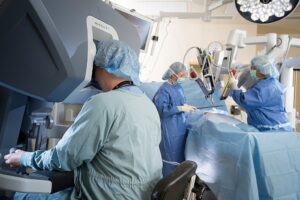
Source: Wikimedia CC
ROBOTICS IN NEUROSURGERY
The advent of robots into the world of technology could easily be put down to man’s insatiable desire to be a creator. However, the use of robots in healthcare especially in invasive procedures is truly a win-win situation. Robotic Science and its implementation in delicate surgery like the arena of Neurosurgery is a viable proposition. Robots give the needed advantage to achieving desired results and the patient recovery rate and success quotient both are quite encouraging.
For the last few decades, robot-directed and robot-assisted surgical procedures have achieved veritable success and they come with several tangible advantages. Foremost in this list is that the tissue invasion is minimum, hence, the post-procedure trauma is much reduced. Research endeavors reveal that recovery rate and post-episode complications are manageable for patients of all age groups.
Secondly, robot operatives can be accurately directed, to the point of focus, since they can be manipulated through an automated mode. If one considers the spearheaded and intricate area of neurosurgery, this approach is observed to be overall really efficacious and with evidence-backed data of success.
In the case of neurosurgery, the main deterrent has always been a limitation of access to the point of surgery due to the complex structure of the human anatomy. Moreover, the neurological profile of the human organism is characterized by its intricate and enmeshed network. Hence, the novel approach to robotic science is a pivotal tool if it is coupled with human knowledge, skill, and dexterity.
Many researchers recommend this symbiotic approach which uses the best of both skill-sets.In keeping with global access to Healthcare in general and neurosurgery-related aspects in particular, there are many inroads in robotic tie-ups which are worth mentioning. As an overview, robots are amenable to storage, mining, and organization of virtual data. They are capable of relatively fault-free and superior spatial resolution and geometric accuracy.
Additionally, they are equipped with commendable dexterity, and speed of maneuver and moreover, are capable of steady motion for appreciable time periods. Robotic surgery and its variations allow simulation of virtual procedures which turn out to be great learning practices for surgeons who are new to this specialty.
Obviously, their surgical acumen can easily be actualized in a safe framework. On the other hand, robotic science affords senior professionals a much-needed opportunity to generate a simulated environment and then conduct a rehearsal for high-risk procedures in neurosurgery. A comment definitely has to be made, to underline, that the details of procedures, outcomes, and even lapses in neurosurgical operations become repositories of data garnered and stored. These are of tremendous value as reference material for the research and development of this science. They are treated as Robotic libraries and used globally.
The ideal utilization of this promising science is to strike an optimization of manual and automation, man and machine, and to strive to reach the pinnacle of holistic wellness and healthcare for all. The obvious implication for the arena of neurosurgery is mammoth and it is the need of the hour. The approach of course has to be a symbiotic one. At this moment it is definitely the sustainable approach.
The author acknowledges the use of authentic medical literature to structure this article.
Sign up for the QuackTrack.org newsletter below!














